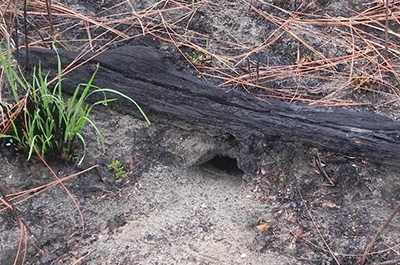Gopher Tortoises

Gopher tortoises have been around for millions of years, but today they are a threatened species in Florida and several other states. Their imperiled status means that these tortoises are protected by state law and must be left alone. The major issue facing these gentle and important creatures is that human development keeps encroaching on their native habitats.
Many are found in north central Florida, but they can be found throughout the state except in the southern tip. The gopher tortoise prefers dry habitats such as longleaf pine scrub, oak sandhills, oak hammocks, sand pine scrub, wiregrass flatwoods, dry prairies, and coastal dunes.
Ecological Role
One of the reason gopher tortoises are so heavily protected is that they play an important role in many Florida ecosystems. They are a keystone species, meaning that many other species in the ecosystem rely on gopher tortoises to survive. The gopher tortoise creates burrows in the ground which are more like an underground village—they provide homes to a variety of other creatures in addition to the tortoise.
In fact, hundreds of different species of mammals, reptiles, amphibians, insects and even birds have been known to use gopher tortoise burrows. Different animals use the burrows in different ways—sometimes to provide quick shelter from predators, or as a temporary refuge from the fires which are a natural part of the landscape in upland ecosystem. Some of the animals that use these burrows include indigo snakes (another protected species), foxes, and burrowing owls (yet another protected species).
The gopher tortoises also help the ecosystem by grazing on low-growing plants and passing the seeds, distributing them to different locations.
Gopher Tortoise Burrows

You can identify a gopher tortoise burrow by its distinctive features. The entrance will be wider than it is tall. The hole also has a mound of sandy soil in front of the entrance. Holes made by a gopher tortoise are almost exactly shaped like its shell—more of an oblong circle that is flattened on the bottom then a totally circular hole.
If you have a gopher tortoise on your property, keep pets or children away from its burrow. Since gopher tortoises are a threatened species, both the tortoises and their burrows are protected under state law and must be left alone.
You can help by adding tortoise-friendly plants that it can eat. Tortoises have a varied diet including grasses, bean family plants, flowering weeds and low-growing fruits. Plant a variety of low-growing native plants in your yard, and remove invasive exotic plants.
Additionally, avoid mowing, digging, or driving over the ground within twenty-five feet of the burrow to help protect it.
